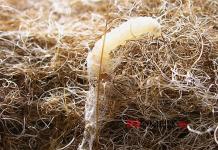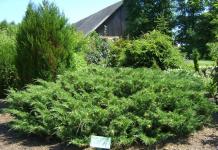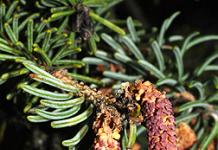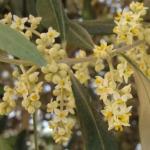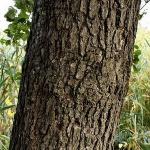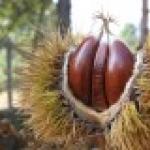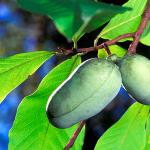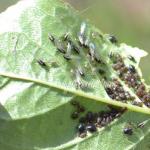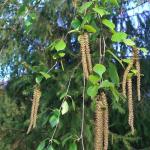Gray alder - Alnus incala (L.) Moench.
Black alder (sticky) - Alnus glutinosa (L.) Gaerth
Birch family - Betulaceae
Other names:
- oleshina
- volha
- Wilha
- eloha
- elshina
- leshinnik
- oleshnik
- alder cones
Botanical characteristics. Both species are tall shrubs or small trees. They differ in the shape and edge of the leaves, the color of the bark and the shape of the fruit: gray alder has sessile “cones”, and black alder has stalks. Gray alder has smooth, silver-gray bark. The leaves are ovate-elliptical, with a serrated edge, dark green above, lighter below, pubescent, non-sticky, with a pointed tip. The flowers are unisexual: staminate - in long catkins, pistillate - in short oval spikelets, covered with scales, no perianth. Sticky alder has dark brown bark with cracks, young branches are smooth, often sticky, reddish-brown. The leaves are round, notched at the top, with a serrated edge. Young leaves are shiny, sticky, and fully developed - dark green above, light green below. Flowers in drooping earrings. The fruit is a nut with a narrow wing. Alder blooms in early spring before the leaves bloom, in March-April. The green scales covering the staminate and pistillate flowers grow by autumn, become woody, turn black and form infructescence - alder cones that hang on the tree all winter. The fruits ripen in September-October.
Spreading. Sticky alder has a wider range. It grows in the steppe and forest-steppe zones of the European part of the country, Western Siberia and the Caucasus.
Habitat. Along the banks of rivers, streams, ravines, and swamps, “black alder forests” are found. Gray alder forms shrub thickets. Grows in the undergrowth of damp mixed spruce forests, in damp meadows, along river banks. Both species are moisture-loving plants.
Preparation. Raw materials are collected in autumn or winter. The lower short branches along with the cones are cut off with pruning shears or shaken off the trees; the cones are clearly visible in the snow.
Security measures. It is not allowed to break branches or tear off alder fruits from them.
Drying. In ovens, dryers or in air. The raw materials are laid out in a thin layer, stirring occasionally.
External signs. According to the Global Fund XI, the infructescence is ovoid or oblong-oval, with or without nuts; solitary, with or without remains of a stem no longer than 1.5 cm, or collected several on a thin stem. The infructescence consists of a rod on which fan-shaped scales are densely located. Length of infructescences up to 20 mm, diameter up to 13 mm. The smell of the raw materials is weak, the taste is astringent. High humidity, branches without fruit, stalks longer than 1.5 cm, and organic and mineral impurities reduce the quality of raw materials.
A decoction of the raw material (1:10) with a solution of iron-ammonium alum forms a black-blue color.
Chemical composition. Alder cones contain tannins, which include tannin (about 2.5%) and gallic acid (up to 4%). Flavonoids, caffeic, chlorogenic and protocatechinic acids are found in the leaves. Alder bark contains tannins, triterpene compounds, triterpene alcohol taraxerol (alnulin), flavonoids (hyperoside and quercitrin). Triterpene compounds, the triterpene ketone glutinone, taraxerol, taraxerone, and lupeolin, have been isolated from the bark of the sticky alder.
Storage. In dry, well-ventilated areas. Shelf life: 3 years.
Pharmacological properties. Alder cones have astringent, anti-inflammatory and disinfectant properties. Volatile fractions of phytoncides from leaves and bark have a detrimental effect on protozoa.
Medicines. Alder fruits, collections, decoction.
Application. An old folk remedy. Introduced into scientific medicine in the 40s of the 20th century. prof. D. M. Rossiysky.
An infusion of fruit cones (cones) and a decoction of alder bark are prescribed for acute and chronic enterocolitis, dysentery as an adjuvant in treatment with antibiotics and sulfonamides. An infusion of alder cones helps reduce fermentation and putrefactive processes in chronic enterocolitis accompanied by diarrhea. Already on the 2nd day of treatment, the number of bowel movements decreases, tenesmus and pathological impurities disappear, and feces become more formed. A quick and sustainable treatment effect is ensured by the natural combination of tannin, triterpene compounds and quercetin in alder fruits. Decoctions of alder cones are prescribed to patients with diseases of the digestive system to prevent exacerbation of chronic intestinal infections. To normalize the intestinal microflora, decoctions of alder cones are used in patients with dysbacteriosis.
At home, prepare an infusion of alder fruit (Infusum fructusum Alni) at the rate of 2 tablespoons of raw material per 200 ml of water. Take 1 tablespoon 3-4 times a day.
The plant is a flowering plant and belongs to the birch family. Blooms in early spring, pollination occurs by wind. The trunk has a slender shape and smooth bark. The leaves are round and do not change color. So they fall green in the fall. There are more than fifty species of this plant, but two of them are considered the most common. So, we present – gray, black alder, description and photo, cultivation. Let's look at each representative in more detail.
Black alder description and photo

This is called so because of the stickiness of shiny leaves and black bark, which is observed in older trees. This species grows up to twenty meters in height. It is believed that black alder loves solitude - it is impossible to find other trees nearby.

Blooms in April. It bears fruit in cones that fully ripen within a year. The plant loves light and moisture. Grows in moist soils.

In a number of regions, black alder is included in the Red Book. This species is often planted near ponds, in parks and along alleys.
Gray alder description and photo

It looks different from black alder. The trunk is slightly curved, the bark is grayish in color. The foliage is the same color.

It blooms with earrings that are distinguished by a brownish tone. The plant is more light-loving, but less demanding on growth conditions.

The tree is able to grow even on soils that are depleted and waterlogged. It tolerates winter cold and wind better. Capable of propagation by seeds, cuttings and even pieces of bark.

The active growth phase is observed at a young age, when gray alder creates impenetrable thickets. This feature is often used in land reclamation when there is a need to strengthen slopes and banks.
Rules for care and cultivation
Alder does not care about soil composition; it can grow even on sandy soils on its own. The secret is that it is on the roots that absorb nitrogen. Thus, the soil is enriched.
The plant is light-loving, respects moist lands, quickly responds to drought, and tolerates frost well. It is replanted in the usual way, in the spring. Water only in hot weather.
Alder may not be supported with nutritional compounds. The fact is that the root system is capable of producing the nitrogen necessary for growth on its own.
Benefits and Applications
The tree is not durable, but has a uniform structure. The wood is light and soft, easy to process. Alder is widely used for industrial purposes and has also found its place in medicine.
Musical instruments are made from alder material, since its surface does not crack when dried. The softness of the wood has become the basis for the use of alder for artistic cutting.
If wood is treated with ammonia or drying oil, it can be used to make excellent decorative furniture.

By being exposed to moisture for a long time, alder improves its strength; barrels and underwater structures can be made from it.

| Taxonomy on Wikispecies |
Images on Wikimedia Commons |
|
Gray alder, or White alder, or Eloha(lat. Alnus incana) - tree, species of the genus Alder ( Alnus) family Birch ( Betulaceae).
Botanical description
|
|
||||||||||
It is less demanding on soils than black alder, although it is rarely found on poor, dry sandy soils; It tolerates waterlogging better than black alder. Prefers calcareous, moist soil and free standing, although it often grows in dense plantings. It enriches the soil with nitrogen. Winter-hardy. More shade-tolerant than aspen and silver birch, but prefers well-lit habitats.
The most common types of gray alder forests are sorrel and sorrel alder on fresh soddy-podzolic, strongly or moderately podzolized soils. They arise in the place of oxalis spruce forests or blueberry gray alder forests. In the sorrel and sulfur forests, intensive restoration of spruce occurs and their rapid replacement by spruce forests. Along the banks of rivers, streams, in ravines, and moist depressions on humus-gley, loamy and clayey soils, meadowsweet and large-fern gray alder forests appear in small areas. They arise on the site of coniferous, broad-leaved spruce and broad-leaved spruce-black alder forests and are capable of long-term existence. On sandy and poorly moistened soils, gray alder forests rarely appear and are quickly replaced by pine and spruce. Such gray alder forests appear in burnt areas and clearings of lingonberry pine forests. Sedge gray alder forests appear even less frequently on waterlogged soils. They are short-lived and have an admixture of birch and willow. On the poor fresh soils of watersheds, in place of blueberry spruce forests, very short-lived blueberry gray alder forests appear, giving way to black alder forests of sorrel and reed grass. Cereal grey-alder forests appear on the site of abandoned arable lands. They are unstable and are replaced by spruce forests.
Meaning and Application
Gray alder is used in forest reclamation plantings in the north of the forest-steppe to secure river banks, slopes and ravines.
Gray alder firewood burns well, but charcoal does not hold the heat. Alder firewood was used by Russian peasants to burn soot from chimneys, especially after using birch firewood. Firewood is valued for the production of drawing (drawing) coal and coal used to make gunpowder. Alder shavings are considered the best for packing fruit.
Gray alder in spring gives bees a lot of pollen, which covers young leaves and shoots. Beekeepers recommend feeding bees with alder pollen before it blooms. To do this, cut the branches and place them in a warm room in a sieve covered with paper. As soon as the anthers open, the sieve is gently shaken and the pollen is poured onto the paper. It is mixed with honey and sugar syrup and given to the bees. The leaves are used to feed goats and sheep. The buds and tops of the branches serve as food for hazel grouse and grouse in winter.
Diseases and pests
Pathogenic fungi
Classification
Taxonomy
View Gray alder belongs to the genus Alder ( Alnus) subfamily Birch ( Betuloideae) family Birch ( Betulaceae) order Beeceae ( Fagales).
| 7 more families (according to APG II System) |
1-2 more types | |||||||||||||||
| order Beech-flowered | subfamily Birch | view Gray alder |
||||||||||||||
| Department Flowering or Angiosperms | family Birch | genus Alder |
||||||||||||||
| 44 more orders of flowering plants (according to APG II System) |
another subfamily Hazel (according to APG II System) |
about 45 more species | ||||||||||||||
Varieties
Within the species there are several varieties:
- Alnus incana subsp. incana
- Alnus incana subsp. rugosa (Du Roi) R.T.Clausen
- Alnus incana subsp. tenuifolia (Nutt.) Breitung
Alnus incana
Birch family - Betulaceae
Parts used: fruit, bark
The popular name is oleshnyak, volkha, vilha, eloha, elha, elshina, leshnynik, oleshnik
Pharmacy name - alder cones - Fructus Alni
 Botanical description
Botanical description
Gray alder is a tree up to 20 m high or a shrub with a narrow ovoid crown and a trunk with a diameter of up to 50 cm. The trunk is rarely straight and cylindrical, often with longitudinal depressions and humps, covered with light gray, always smooth. The shoots are first greenish, later brown or blackish-gray, not sticky, but covered with gray fluff or felt and light lenticels. The leaves are arranged in three rows, ovate-elliptic or ovate-rounded, 4-10 cm long, 3.5-7 cm wide, with a round or heart-shaped base, sharp apex along the edges, young leaves are densely pubescent on both sides, well developed - smooth on top, pubescent below, gray, cuttings 1-4 cm long, softly hairy.
The flowers are unisexual, collected in earrings. Male catkins in groups of 3-5, long, sessile or on short stalks, staminate flowers in dichasias of 3. Female catkins short, oval, almost sessile, of 3-8, pistillate flowers in dichasias of 2. Buds stalked, ovate or ovoid-spherical, slightly blunt at the apex, downy. The fruit is a single-seeded nut, which are collected in oblong ovoid fruit in the form of dry cones up to 2 cm long, which do not disintegrate in the fall. The cones are elliptical black-brown, 12-15mm long, 7-8mm wide. The seeds are small, look like flat nuts up to 2 mm long, red-brown with a very narrow transparent wing. They spill out of the cones in early spring. The weight of 1000 nuts is 0.5-0.9 g.
 Alder blooms from early March to late April. The fruits ripen in autumn. Fruiting annually, abundant. The seeded cones hang on the tree until spring. Seed specimens begin to bear fruit at 8-10 years of age; coppice from 5-7 years.
Alder blooms from early March to late April. The fruits ripen in autumn. Fruiting annually, abundant. The seeded cones hang on the tree until spring. Seed specimens begin to bear fruit at 8-10 years of age; coppice from 5-7 years.
The alder root system is plastic, well developed and moisture resistant. As a result of symbiosis with bacteria, alder roots form nodules that have the ability to absorb nitrogen, thanks to which alder increases soil fertility.
Alder reproduces well by seeds and has a high ability to regenerate by sprouts, forming dense stands.
Gray alder is found in the steppe and forest-steppe zones of the European part of the country, Western Siberia and the Caucasus. It grows in river and stream valleys, on the outskirts of swamps, along the banks of ponds and lakes, on forest edges, clearings, and abandoned arable lands. Sometimes it forms continuous thickets.
Collection and preparation
Lignified fruits are harvested in the autumn-winter period. The collected raw materials are spread in a thin layer and dried in the open air under canopies, as well as in ovens and heated dryers, stirring occasionally.
The finished raw material is a dark brown or brown fruit with a weak non-specific odor and a slightly astringent taste.
Active ingredients
Sulfur alder cones contain alkaloids, tannins, phenolcarboxylic acids, flavonoids, fatty oil, triterpenoids, aliphatic alcohols, and steroids. The bark contains triterpenoids and tannins. Alder leaves contain provitamin A (carotene), vitamin C, phenol carbonic acids, tannins, and anthocyanins.
 Healing effect and application
Healing effect and application
It has gastroprotective, antiulcer, antimicrobial, hemostatic, diaphoretic, anti-inflammatory, astringent and disinfectant effects.
In folk and scientific medicine, preparations from gray alder are used as an astringent and hemostatic agent, especially for diseases of the gastrointestinal tract, acute and chronic enteritis and colitis (acute and chronic inflammation of the small and large intestines, as well as to increase milk production in nursing mothers. Alder also used for hemorrhoids, stomatitis and bleeding gums, dysentery, pulmonary tuberculosis, rheumatism, gout, itchy rashes, scrofula, dermatitis and burns.
Decoctions of alder bark or cones are used for rheumatism, gout and other joint diseases, giardiasis, as well as for rinsing the throat and mouth during inflammatory processes and colds and in children.
Foot baths made from alder leaves have the ability to relieve fatigue after a long walk. For mastopathy, it is recommended to apply steamed fresh leaves to the sore breast. A decoction of alder leaves was used for cancer of the breast, pylorus, pancreas, duodenum, esophagus, rectum, throat, tongue, uterus and other tumors. Alder leaves are considered a good diaphoretic in Russian medicine.
A decoction of male inflorescences of bush alder is used for washing purulent wounds, for pneumonia, and malaria.
Alnus incana
Taxon: Birch family (Betulaceae)
Folk names: white alder, eloha, oleshina
English: Gray Alder, (Amer) Speckled Alder
Botanical description of alder
Gray alder is a low tree or bush with an ovoid crown. On moist fertile carbonate soils, in 50-60 years it reaches a height of up to 25 m and a trunk diameter of up to 30 cm. On infertile soils, alder sometimes grows as a tall bush, living up to 60-70 years, less often - up to 100 years. The alder root system is plastic, well developed and moisture resistant. As a result of symbiosis with bacteria, alder roots form nodules that have the ability to absorb nitrogen, thanks to which alder increases soil fertility.
Alder reproduces well by seeds and has a high ability to regenerate by sprouts, forming dense stands.
The trunk is covered with gray smooth bark. Young branches are reddish-brown, with whitish lenticels, sticky or in places with liquid pubescence. Leaves are ovate-elliptic or ovate-rounded, 4-10 cm long, 3.5-7 cm wide, with a round or heart-shaped base, sharp apex along the edges, young leaves are densely pubescent on both sides, well developed - smooth above, pubescent below, gray , cuttings 1-4 cm long, soft-haired. Young shoots, buds and pedicels are also pubescent. The flowers are unisexual, collected in earrings. Male catkins are in groups of 3-5, long, sessile or on short stalks, staminate flowers in dichasias of 3. Female catkins are short, oval, almost sessile, of 3-8, pistillate flowers in dichasias of 2. The fruit is a one-seeded nut. The fruits are collected in oblong ovoid fruits in the form of dry cones up to 2 cm long, which do not fall apart in the fall. The cones are elliptical black-brown, 12-15 mm long, 7-8 mm wide. The seeds are small, look like flat nuts up to 2 mm long, red-brown with a very narrow transparent wing. They spill out of the cones in early spring. The weight of 1000 nuts is 0.5-0.9 g. Alder blooms from early March to late April. The fruits ripen in autumn.
Area, geographical distribution
Gray alder has a typical temperate Eurasian habitat. The alder range covers almost the entire part of Europe, with the exception of the polar regions and some southern regions of the Mediterranean. Gray alder is also found in places in Asia Minor and in some oases of North Africa. In northern Europe, the border of the alder range runs through Norway, Sweden to the coast of the Gulf of Finland and into the northern regions of Russia, and further through Karelia north of Lake Onega, reaching the coast of the White Sea, along the Northern Dvina River to Veliky Ustyug, reaching the upper reaches of the Kama rivers and spurs Ural. The southern border of the alder range extends from the south of Spain from the Strait of Gibraltar to Sicily, along the southern coasts of Italy, the Balkan countries, Greece to Turkey and, stretching through the North Caucasus, extends to the Caspian Sea, reaching Iran. The western border of the alder range is France, Belgium, the Netherlands and Great Britain, with the exception of Scotland. The eastern border of the range of gray alder is considered to be the Ural Range. In Western Siberia and Central Asia, gray alder is less common. Individual alder thickets were found in the vicinity of Tyumen, in the south of Tobolsk. Alder is also found in places in the foothills of the Altai Mountains.
Literature data on the vertical limit of alder distribution are limited and have some contradictions. Thus, in Norway, alder rises to a height of 325 m above sea level, in the Alps and Carpathians, gray alder rises to a height of 1160-1210 m, in the Tyrolean mountains, to a height of 1230 m. In the North Caucasus, alder is found at an altitude of 1220-1520 m above level sea, forming closed plantings of high productivity there (Davydov M.V., 1979). In the phytocenotic aspect, gray alder is a boreal species. Alder grows mainly in damp and marshy areas, and in some places forms continuous alder forests. It also grows singly and in small groups along the banks of rivers, lakes, ponds and in wet gullies.
Medicinal raw materials
Three types of alder are used in medicine and pharmacy - gray alder - Alnus incana and related species sticky alder - Alnus glutinosa And bearded alder - Alnus barbata. In addition to these species, in various regions of the world in traditional medicine, raw materials from the following types of alder are also used: Japanese alder, Maksimovich, red, wrinkled, Siberian, thin-leaved, etc.
For medicinal purposes and for the needs of the pharmaceutical industry, infructescences (cones) are prepared ( Fructus Alni, Alabaster Alni).
Infructescences are harvested in autumn or winter before the onset of warm weather. Harvesting of infructescences is carried out mainly in the spring during cutting or cleaning of alder trees.
When harvesting fruit from trees, pruning shears are used to cut off the ends of thin branches, and then the fruit is torn from them. Freshly collected raw materials are placed in bags and delivered to the drying site. Fruits that have fallen from trees on their own are unsuitable for use in medicine and the pharmaceutical industry. Raw fruits are dried in attics, under sheds or in dryers with good ventilation, spread in a thin layer and stirring occasionally.
Raw materials collected from alder should consist of dark brown fruits with scales that open, with or without seeds, with a weak specific odor.
The specified raw materials are official in Russia, Ukraine and Belarus. In industrial pharmacy and scientific and practical medicine in most countries of Central and Western Europe and industrialized countries of the world, alder raw materials are not used.
Biologically active substances
In the phytochemical aspect, raw materials from different species of the alder genus are known primarily as a source of tannins. The fruits of sticky alder contain from 26 to 39% tannins.
In addition to tannins, raw materials from various types of alder contain flavonoids.
Compounds of catechin nature have been identified in the bark and leaves of sticky alder; it has been established that the content of catechins in the bark is 5-8 times higher than in the shoots and leaves.
In addition to catechins, other flavonoid compounds have been identified in lipophilic extracts of leaf buds of alder species such as Alnus crispa, A. Japonica, A koecynei, A. sinuata, collected in winter.
It should be noted that the presence of volatile phytoncides was detected in the leaves of gray alder. However, the presence of volatile phytoncides in the leaves of sticky alder has not been established.
History of use in medicine. Use in folk medicine
Various types of alder have been known to mankind since ancient times, primarily as a valuable tree that was used on the farm to produce wood. The ancient Celts planted alder near settlements, considering it a talisman against ghosts, vampires and others. In ancient times, alder was also a favorite tree of sorceresses, who dyed their hair a fiery color with alder wood. It was also believed that if you whistle into a pipe made of alder wood, you can calm the wind (Bodlak J., 1999). In the historical and ethnographic literature there is practically no data regarding the widespread use of various parts of alder in ancient medicine in most European countries. However, the use of alder in folk medicine of Slavic countries has been recorded.
The barks of alder leaves and fruits were known back in the days of Kievan Rus. In particular, decoctions of alder bark were used to rinse the throat and mouth during inflammatory processes. Alder leaves were considered a good diaphoretic in medieval Russian medicine. In Russian folk medicine, alder has long been known as an effective remedy for treatment. Quite original and popular in some regions of Russia was the method of treatment with dry baths from fresh alder leaves. For this purpose, a large wooden barrel was filled with freshly picked alder leaves and covered with a blanket to keep the leaves warm. After that, a person with a cold was buried in such a barrel up to the waist or up to the neck and kept for an hour to warm up. Data from ethnographic studies provide information on the popularity of the above dry baths for rheumatism, gout and paralysis. In the past, Russian healers believed that foot baths made from alder leaves had the ability to relieve fatigue after a long walk.
In the famous Russian medical manual of the 19th century. “Healing book - herbal book by N. Grigoriev,” published in 1882, indicated that alder bark should be included in the list of Russian anti-fever drugs as an effective substitute for imported quinine bark. This herbal book contains the recommendation of the English doctor Murray, who advised applying fresh alder leaves to the nipples of mothers to enhance the secretion of milk from the breast. Some sources of literature from Russian ethnography provide information about the use of alder fruits (cones) and bark in Russian folk medicine for colitis and enterocolitis, which were accompanied by diarrhea, and for dysentery. In particular, prof. D. M. Rossiysky (1944) pointed out that remedies from the bark and cones of various types of alder were widely used in Russian folk medicine as an effective hemostatic agent. “The Complete True Common Russian Medicine Book,” published in Moscow in 1866, gives the original Russian method using fresh alder wood. At the same time, cod the size of a match was planed from alder wood and heated over an open fire, leaving a quarter of the cod without fire. After a foamy liquid began to flow out of the cold end of the cod, it was smeared on the warts. This procedure had to be performed daily until the wart disappeared.
Various parts of alder were also widely used in Ukrainian folk medicine in the past. The effectiveness of folk treatment with alder remedies for many colds in Volyn and Polesie was indicated in their monographs by such famous Ukrainian folk herbalists as M. A. Nosal, I. M. Nosal and V. Komendar. Fresh alder leaves and a decoction of them were used in Ukrainian folk medicine for washing and in the form of compresses in the treatment of wounds and abscesses. In Polesie, a decoction or infusion of alder cones was used internally for gastrointestinal diseases. In the Poltava region, alder bark was part of medicines that were used in the treatment of patients with venereal diseases ( Boltarovich S., 1994). In modern Ukrainian folk medicine, alder fruits and bark in the form of decoctions and teas are used for dysentery, stomach pain, pulmonary tuberculosis, rheumatism, rheumatoid arthritis, allergies, hemorrhoids, as gargles for bleeding gums and nosebleeds and stomatitis, as well as for lotions and baths for wounds and ulcers on the skin, for scrofula, itchy rashes, burns and dermatitis.
In Poland, alder bark is used as a folk remedy for fever, conjunctivitis, sore throat and bleeding. Powdered dry alder leaves are used as lotions for skin diseases.
In Belarus, a decoction of dried alder catkins is consumed orally and applied as a lotion to sore spots for childhood eczema and diathesis. In addition to sticky alder, remedies from bushy and pubescent alder were also used in folk medicine. In Japanese folk medicine, remedies from Japanese alder were used. There is evidence that bushy alder brooms are used to steam baths for rheumatism and. The bark of the pubescent alder is used in the form of lotions for rheumatism; a decoction of the fruits of this plant is used by the indigenous Nanais living in the south of Siberia for treatment.
The peoples of the Russian Far East use a decoction of male inflorescences of fruticose alder to wash purulent wounds. Residents of Primorye made lard ointment from the bast parts of bushy alder wood, which they used to treat wounds. A decoction of Japanese alder bark was used in the past to stop postpartum hemorrhage in women giving birth (Schroeter, 1975).
A decoction of the roots of bushy alder and a decoction of the roots of pubescent alder were used to treat scrofula, and a decoction of the infructescences was used for pneumonia and tuberculosis (Khvorost O.P. et al., 1984). An infusion of young branches of bushy alder is used for gonorrhea, and infusion of sticky alder is used for syphilis (Voronina, 1952).
There is evidence of the use of sticky alder leaves and tints alder bark in the treatment of cancerous tumors ( Gammerman, Semenova, 1959; Shimkunaite, 1964). In scientific medicine, the fruits of gray and sticky alder began to be used during the Second World War in the form of galenic preparations in the former Soviet Union for the treatment of colitis, acute and chronic enterocolitis, diarrhea and dysentery ( Russian D. M., 1942; Chasse, 1952), and also as a wound healing agent ( Gammerman A.F. et al., 1957). Aqueous extracts from the roots and fruits of alder were successfully used in the 50s by Professor D. M. Rossiysky in the treatment of acute and chronic enterocolitis, accompanied by diarrhea.
The positive effect of alder cone fruits was noted in the treatment of diarrhea in children.
Pharmacological properties
Raw materials from various types of alder have been studied as a source of medicines that affect the activity of the gastrointestinal tract. When studying the pharmacological properties of alder extract, it was found that it has a weak antispastic effect on the isolated duodenum of rats and dogs, as well as on the coronary vessels of rabbits.
R. Cachen and Poison (1971) found that an extract obtained by maceration from the bark and leaves of alder, grey, green and cordate, showed a weak antispastic effect on the isolated duodenum of dogs and rabbits, as well as on isolated coronary vessels of rabbits. In addition, the extract had pronounced choleretic activity.
At the end of the 40s in the former Soviet Union, two preparations were obtained from sticky alder and a closely related species, bearded alder: aglutin - a liquid extract from the leaves of sticky alder, which had a laxative effect, and tkhmelini - a dry extract from the fruit of bearded alder, which had an astringent effect. action and was recommended for the treatment of gastrointestinal disorders ( Aladashvily A., Kvirtsaridze Sh., 1949; Aladashvily A., Parma I., 1949). In 1967, tannal-type preparations based on halothannins were obtained from gray alder, which had a pronounced antimicrobial effect ( Mityagina S. M. et al., 1967). However, the above drugs have not been introduced into medical practice.
It has also been established that aqueous extracts obtained from alder fruits have antimicrobial activity against gram-positive bacteria, in particular Staphylococcus alba, and do not affect gram-negative bacteria, without affecting the culture of Escherichia coli. According to the data of Bulgarian herbalists, the alcoholic extract of sticky alder showed a bactericidal effect against Staphylococcus aureus, Escherichia coli, Bacillus subtillis (Lambreva et al.).
In experiments conducted on rats with simulated adjuvant polyarthritis, it was found that a thick extract from sticky alder bark reduces the content of proline and hydroxyproline in the blood of animals, which indicates the pronounced anti-inflammatory activity of this extract ( Reshetnyak N.V. et al., 2005).
Ellagic acid, isolated from alder fruits, is a highly active hemostatic, antitumor, antimutagenic and antiviral agent. In addition, it has a pronounced antioxidant effect in doses of 0.501 mg/kg body weight in experimental toxic-allergic myocarditis in rats ( Yakovleva L.V. et al., 1998).
In 1986, employees of the State Scientific Center for Drug Control and the Ukrainian Pharmaceutical Academy (now the National Pharmaceutical University) created a new medicine from the fruits of sticky alder altan, which is recommended for the treatment of ulcerative processes of the gastrointestinal tract. When studying the pharmacological properties of enteric tablets altan, anti-inflammatory, membrane-stabilizing and antispastic effects were established.
Toxicology, side effects, contraindications for use
Medicines from alder fruit are non-toxic and do not have a negative effect on the cardiovascular, nervous systems and do not affect the composition of the blood ( Alekseev et al., 1988). However, uncontrolled consumption of alder fruits in the form of aqueous extracts can cause unwanted toxicity and side effects.
Rivne doctors described a fatal case of toxic hepatitis with a fatal outcome, which occurred in a child at the age of 4 months as a result of uncontrolled consumption of a water infusion of alder cones.
Due to the occurrence of loose stools, the mother gave the child a strong infusion of alder cones to drink for 4 days (in total, the child took 500 ml of the strong infusion). In serious condition with severe symptoms of toxicosis, the child was taken to the Rivne regional hospital. Despite emergency therapy, the child’s condition progressively worsened: symptoms of intoxication and adynamia increased, lethargy, frequent vomiting were observed, and the liver became enlarged. After ten days in the hospital, the child died. Pathomorphological diagnosis data confirmed that the child’s death was caused by increasing hepatargia ( Yanchuk N. Ya., Samchuk E. O.). In this regard, we consider it advisable not to use alder fruits in the form of infusions and decoctions in the treatment of diseases of the digestive tract in newborns without the permission of a doctor.
A contraindication to the use of drugs from alder may also be increased sensitivity of patients to these drugs, which can manifest itself in the form of allergic reactions. If you are hypersensitive to alder preparations, you should immediately discontinue the course of treatment with these medications.
The experiment also studied the toxicity of the substance and tablets of ellagic acid obtained from alder bark. With long-term administration of ellagic acid in doses of 1 and 10 mg/kg, no toxic effects were found on the functions of vital organs and systems of experimental animals. However, the longest possible use of the above drugs can cause depression of the central nervous system ( Ivakhnenko A.K., Sakharova T.S., 1999).
Clinical Application
Due to the content of tannins and triterpenoids, in clinical settings, medicinal preparations made from various parts of alder are used primarily as astringents for inflammatory diseases of various etiologies. Alder bark in the form of a decoction is used for rinsing the mouth for sore throat and laryngitis (Norra N.A., 1975). Aqueous decoctions from the bark, leaves and inflorescences give a good effect in the treatment of acute and chronic enterocolitis.
Prof. S. S. Stankov and N. V. Kovalevsky in the monograph “Our Medicinal Plants and Their Medicinal Use,” published in 1945, indicate that preparations made from alder cones have shown good effectiveness in clinical conditions in the treatment of acute and spastic colitis, as well as dysentery. These authors claim that herbal remedies from alder fruits are astringent and have a slight hemostatic effect on the intestinal mucosa. In this case, it is recommended to take aqueous nastiya of alder cone Infusum amentorum Alni ex 0.4-200.0, which is prepared ex tempore and taken 1/2 cup during the day. French herbalists N. Leclerc (1976) and J. Valnet (1972) note that alder fruits cause a decrease in body temperature, and they can be used for fever caused by the malaria mosquito. According to I.E. Akopov (1977), alder has a hemostatic effect, and products from it can be used for epistaxis, injecting them locally into the nasal passages.
The use of the drug altan in the complex treatment of patients with acute intestinal infections increases the effectiveness of therapy, speeds up recovery, reduces the frequency of protracted forms and repeated bacterial excretion. In patients with salmonellosis and shigellosis, which occur against the background of concomitant gastrointestinal pathology, the use of the drug can significantly reduce the frequency of complications and the risk of developing exacerbations of chronic diseases of the digestive system (Boychuk O. P.).
Medicines and dietary supplements
1. Altan - Altanum (Borshchagovsky chemical and pharmaceutical plant, Ukraine).
Pills. 1 tablet contains 10 mg of the substance altan in terms of dry matter; altanin content - 60%.
The product has gastroprotective, antiulcer, antimicrobial, anti-inflammatory and reparative activity. The drug does not affect the secretory activity of the stomach.
Used for gastritis of various etiologies, regardless of the nature of the disturbances in the acid-forming function of the gastric glands, non-ulcer dyspepsia, chronic gastroduadenitis, in the complex treatment of gastric and duodenal ulcers, colitis and enterocolitis.
Take orally 15-20 minutes before meals, 1 tablet 3 times a day. The duration of treatment depends on the severity of treatment and is 1-2 months. Children and adolescents from 9 to 16 years old, 1 tablet 2 times a day. With a long course of treatment, manifestations of hypersensitivity to the drug in the form of allergic reactions are possible, which require discontinuation of the drug and symptomatic therapy.
2. Altanova ointment 2% - Unguentum Altani (Borshchagovsky chemical and pharmaceutical plant, Ukraine).
Ointment containing 2% altan substance. Available in tubes with a capacity of 2 g. It is used as a means for external use in the treatment of wounds and as a venotonic agent in the treatment of thrombophlebitis and varicose veins.
3. Ultravit schlank (Kernpharm International BV, Netherlands).
Tablets in a package of 125 pcs., 1 tablet contains brewer's yeast - 208 mg; seaweed thallus ( Laminaria saccharina) - 20 mg; roots with leaves

